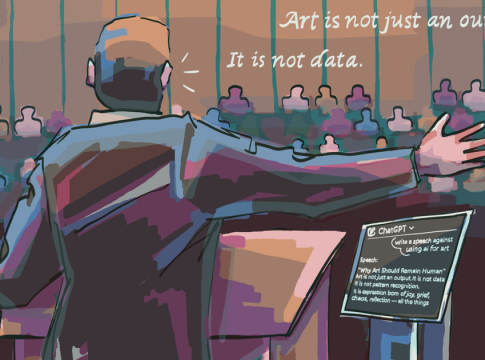The Ethical Quandary of AI in Creative Industries
The Rise of AI-Generated Art
As artificial intelligence (AI) technology advances, its presence in the creative fields is becoming increasingly pronounced. A recent example can be found in C Pam Zhang’s debut novel, Land of Milk and Honey. The book, published by Penguin Random House in 2023, includes images generated by the DALL-E 2 AI, raising questions about the ethical implications of using AI in artistic creation.
Zhang’s novel paints a vivid picture of a dystopian world plagued by climate disasters, contrasting it with the lavish lives of a wealthy family sheltered from the chaos. However, it is the inclusion of AI-generated visuals that has sparked much debate among readers and critics alike.
Copyright Concerns and AI Impacts
In an era where copyright laws are becoming increasingly pivotal to protecting artistic integrity, the decision to utilize AI introduces a layer of complexity. The copyright page of Land of Milk and Honey underscores the significance of copyright in the creative sector, yet it paradoxically highlights the allowance of AI-generated images, which may draw upon uncredited works from numerous artists.
With major publishers like Penguin Random House acknowledging the need for solid copyright protection while embracing AI, a dissonance arises. Are we to believe that copyright is essential only until it encounters the convenience of AI technologies? This contradiction not only undermines the value of creative work but also creates a troubling precedent for future generations of artists and writers.
The Broader Implications for the Literary Community
The concerns extend beyond individual projects. At the recent World Science Fiction Convention (WorldCon) held in Seattle, organizers faced backlash after using ChatGPT to vet participants for potential controversies. The reliance on AI for such crucial tasks not only fell short of ethical scrutiny but resulted in erroneous information, leading to a significant public outcry. The lessons learned here advocate for a more hands-on approach when managing creativity and honoring the voices of the artists involved.
This incident highlights a broader trend where AI, rather than aiding the creative process, complicates it. Many authors, particularly within the science fiction genre, express skepticism regarding the implications of generative AI for artistic creation. The prevailing sentiment is that the convenience of AI comes at the cost of genuine artistic expression and complicity in undermining the livelihood of creators.
A Call for Solidarity Among Artists
The underlying message from critics is clear: solidarity is essential. Creative professionals, be they writers, visual artists, or publishers, must unite against the encroachment of generative AI technologies that prioritize efficiency over ethical considerations. Olivia Waite, a respected science fiction author, aptly noted, "Art is work, plain and simple," asserting that creators should stand together against the exploitation of their labor by predatory tech companies.
With the ongoing evolution of AI, it is crucial for the creative community to actively engage in these discussions and establish guidelines that preserve the integrity of their work. In a world increasingly dominated by AI, reaffirming the value of human creativity and collaboration may be the most significant step forward.
In conclusion, while AI presents exciting opportunities in various sectors, its application within the arts requires careful consideration of ethical boundaries. The debate around AI-generated content is far from over, and its implications for artists, rights holders, and the broader creative landscape should remain at the forefront of this dialogue.

Writes about personal finance, side hustles, gadgets, and tech innovation.
Bio: Priya specializes in making complex financial and tech topics easy to digest, with experience in fintech and consumer reviews.

